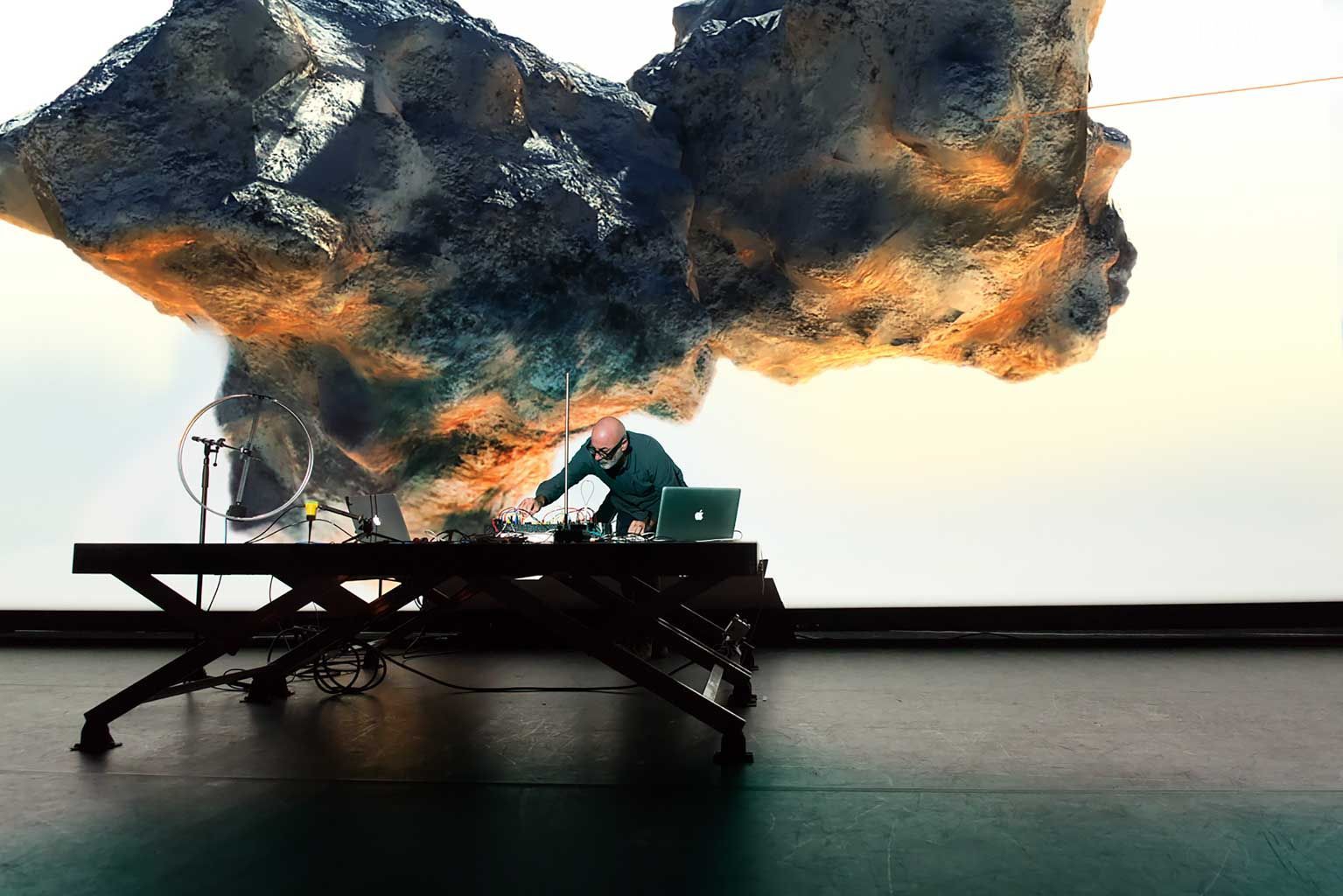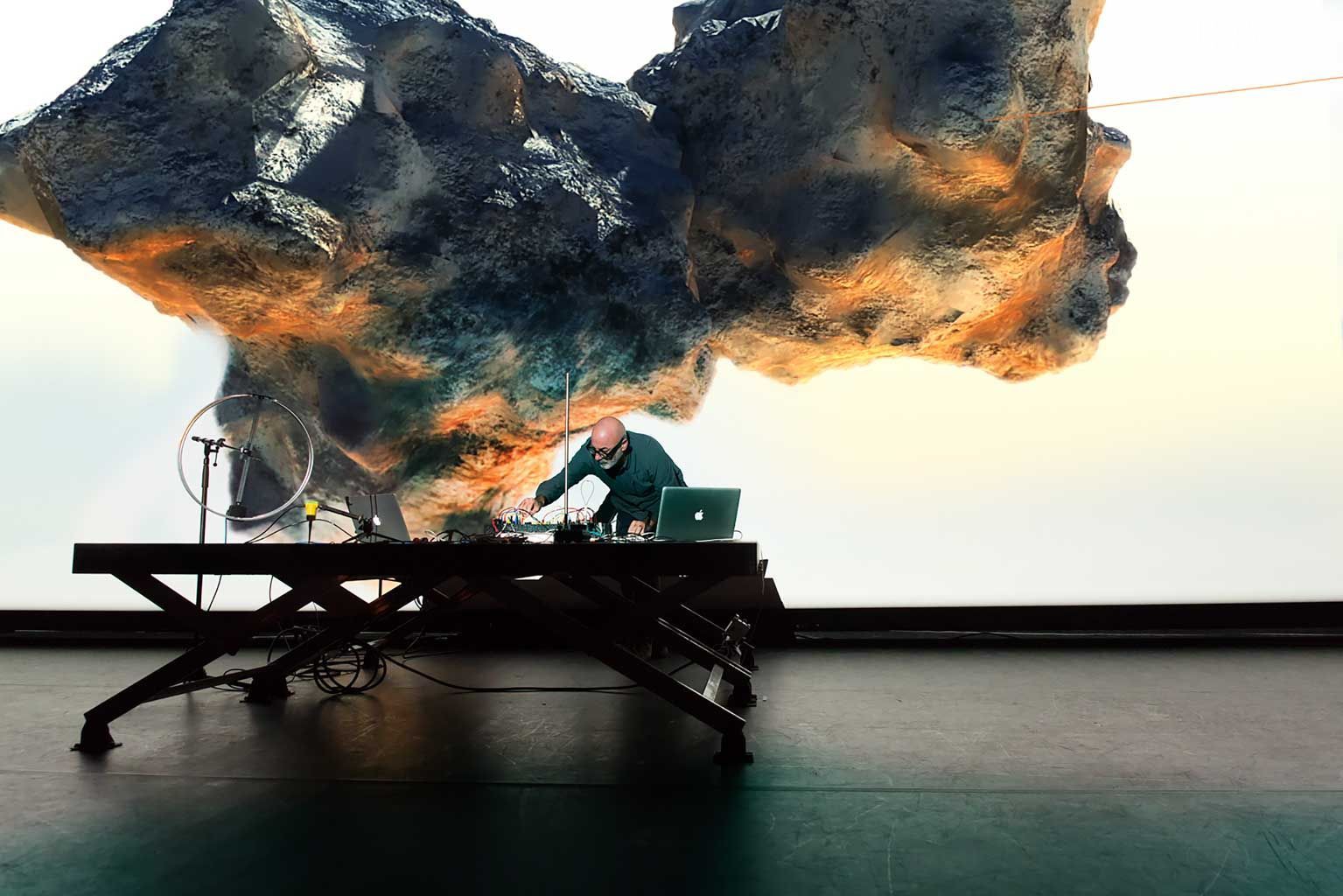
INTERVIEW BY 採訪 X HARRY LIU 劉競晨
TRANSLATED BY 翻譯 X CAI SUDONG 蔡蘇東
IMAGES COURTESY OF 圖片提供 X SONICA 聲音藝術節
Herman Kolgen is an acclaimed multidisciplinary artist with more than two decades of experience on the international media arts scene. As an audiokinetic sculptor, he draws his inspiration from the intimate relationship between sound and image. Kolgen’s work takes the form of installations, video and film works, performances, and sound sculptures. He works in a constant cycle of exploration, at the crossroads of different media, to conjure up a new technical language and a singular aesthetic. His attention to the impact of territories on human life, and the resulting tensions and interplay between these various elements, constitutes the core of his practice. Herman Kolgen has been awarded numerous prestigious prizes including Ars Electronica and his works have been presented at the Venice Biennale and the Centre Pompidou.
赫曼·科肯是一位聲名遠播的跨學科藝術家,二十多年來一直活躍在國際媒體藝術平台。他,聲音動力學雕塑家,在聲音和圖像之間的緊密關係中提取靈感,擅長以裝置、視頻、電影、表演、聲音雕塑的形式創作。在持續不斷的循環探索中,他嘗試了各種不同的媒介,令人不禁聯想到一種新的技術語言和奇異的美感。他將注意力投放在人類領土的影響和導致的緊張局勢上,這些不同要素之間的相互作用構成了實踐的核心。在此期間,科肯被授予了許多著名的獎項,他的作品也曾在威尼斯雙年展,蓬皮杜藝術中心展示過。

ART.ZIP: How did you start working in video art and what’s your creative method?
HK: In my teenage years I started exhibiting, at around seventeen years old, but at the same time I also had a band, so I would play music. Slowly I moved from drums to all types of percussion. I also bought one of the first synthesizers. I’d already started to create more texture. I was not interested in creating tunes [Herman starts to sing a tune] I was more interested in making texture and sounds. At around twenty, I started to concentrate on the synthesizer and the percussion and to create new sounds. I started to make some music films, at this time it was not big. The attention was more to create a mood, I was not interested to compose sound, but I saw the sound or the music like a sculpture, for me, it’s always a sculpture. I move the sound. I sculpt the sound. At the same time, I made paintings, I remember my father saw that I wanted to be an artist. My father said to me: “OK, you want to be an artist, you want to stop school? If you can’t choose between painting and music you will get lost. You need to forget one.” I always have this in my head, but it was impossible for me to choose because I love music and visual art. When I had my first computer that I had enough speed for me to make music and visuals at the same time, that was in the ‘80’s and it totally changed my life. I didn’t have to decide between two mediums, they had become one.
I had some old VHS documentary about war. I put this in the computer, and edited this within the movie, whenever you saw a country, a clip from the country would come in. It’s moved from my camera and old vhs to this new medium. After that I went to my music studio and tried to make music, to fit with this. I composed something very fast. I made maybe three minutes worth of work and I asked one of my friends to have a look and they suggested I sent it to festivals etc. So I sent it to a festival and I won first prize. After that, I knew this was my medium.
ART.ZIP: 您是如何走上視頻藝術創作之路的?您的創作方法是什麽?
HK: 在我十幾歲,大概是十七歲的時候我的作品就開始展出了。但同時,我又有一支樂隊,所以我也在玩音樂。漸漸地,除了玩鼓,我也玩其他的打擊樂器。我買過最早的合成器。那時我已經在創作不同種類的聲感(texture)。我對曲調不感興趣(這時赫爾曼哼唱了一段曲調),但對聲感、聲音的創作卻是樂此不疲。在大約二十歲的時候,我開始專注合成器和打擊樂器,並創作新的聲音。我也開始創作一些音樂片,雖然從現在來看,這些無足重輕。我更關注情緒(mood)的營造,而不是聲音本身。我像看待雕塑一樣看待聲音或者音樂,對我來說,這也都是一種雕塑。我移動了聲音,我雕塑了聲音。同時,我也繪畫。我記得那時我的父親就已經看出我想成為藝術家的打算,他對我說:“好吧,你要成為一名藝術家,你要輟學?如果你不能在繪畫和音樂之間選定一個,那你是會迷失的。你只能忘掉其中的一個。”我一直記得他的話,但要我做選擇卻是不可能的,因為我既愛音樂也愛視覺藝術。後來我有了電腦,我就有辦法兼顧音樂和視覺創作了。那是1980年代的事情了,而這完全改變了我的生活。我沒有必要在媒介中抉擇,因為它們合二為一了。
我有一些關於戰爭的紀錄片錄像帶。我把它們導入電腦,然後剪輯成影片,當影片中出現一個國家,你就能看到關於這個國家的剪輯。這些剪輯要麽來自我的相機,要麽來自其他的老錄像帶,它們都被添加進這個新的媒介(電腦)中。後來,我在自己的音樂工作室裡為這部電影配樂。我創作非常快。我可能花了三分鐘就把作品做出來了,然後我的朋友們建議我可以拿這個作品去參加一些音樂節什麽的。後來我真的參加了,還獲得了一等獎。從那時起,我知道這是屬於我的媒介。
ART.ZIP: So the medium found you?
HK: Probably, yes. The first time I saw it, I think we recognized each other. It’s a love affair! [he laughs].
ART.ZIP: 所以是媒介找到你了?
HK: 是的,很可能是這樣的。我第一次見到它,就覺得我們似曾相識。這是一場戀愛!(他笑了起來)
ART.ZIP: Is there a common concept or theme that runs throughout your work?
HK: I would say that the influence is territories and human or living creatures. It’s the impact of territory on us. I was interested in what happens if you remove something that is very important for a human’s equilibrium. I took a guy, who was totally naked and put him in a water cistern for three days with four submarine cameras. I filmed all of his behaviours and the change in his psychology and facial expression over the days. This was just a human naked in the blue water and what was his is reaction without oxygen. Another project I made after that was called ‘Dust’. Again it’s about territory as we have dust everywhere. It’s a microscopic territory. It’s all about what happens with you, your relationship with your brain and body. The territory now is the Internet. I’m working on three new pieces. I work more in the contemporary art style. So it’s not a performance with new media. I’m more on the side of thinking and reflection, to change your perception of something.
ART.ZIP: 是否有貫穿您所有作品的概念或者主題?
HK: 我認為,處地還有人類或生物給了我很大的影響。[貫穿作品的主題]是處地對我們的影響。我很感興趣的東西是,如果你把維持一個人的平衡非常重要的東西拿掉,會發生什麽事情?我曾經讓一個全身裸體的男人進入一個蓄水箱中三天,用四個水下攝像機記錄他。我把他所有的行為、他的心理和面部表情變化全部錄下來了。一個裸體的人類,置身於藍色的水中,沒有氧氣他會有何反應。這個項目之後我又創作了一個名為《塵(Dust)》的項目。這又是一個探討處地的作品——我們處在一個充滿粉塵的環境中。這裡探討的是極細微的處地問題,以及我們身上發生了什麽——你和你的大腦、身體之間的關係。而現在我們的處地則是因特網。我正在創作三個作品,更多地偏向當代藝術的理念。因而這不是用新媒體表演的項目,我更傾向於思考和反思,改變你對事物的看法。
ART.ZIP: When you started working, they didn’t have a term like digital art. What you define as digital art and what is the meaning of this for you? Are you a digital artist?
HK: I don’t really like the term ‘digital art’. At the beginning, we needed this term to make a split, to explain that digital could be art. It was justified. Digital is so specific, technology is more than digital, you have analogue for example. Digital changed a lot of things, the language is more simple, just 1’s and 0’s. You can take a pixel and take a frequency and in the computer it 0 1 0 1. That’s why we can move pixels with sound and colour things by their frequency. Everything is possible because, on the computer, it’s all the same language. It’s important, but sometimes it can be very reductive. I have other work, which I don’t make digitally. At the Conservatoire de musique in Montreal last spring, they asked me to build a performance. I used a lot of technology, but some of it was just analogue. I work with the concepts, and it depends on the concept and what I want to say. Sometimes I have to use different tools; sometimes I have to build software. It depends on what I really need in order to touch the audience. Sometimes it’s just a pen, a piece of paper and a microphone. I use technology because a lot of things have already been done in painting and sculpture. I don’t want to repeat this. Technology has forced me to reinterpret and it has changed the way we can create and changed our relationship with objects. Technology has given me a new way to see and to modify. It’s a different language. This is why art is always in motion. The way we are living brings new questions. Now, everything is digital and everyone is a digital artist.
ART.ZIP: 您開始創作的時候,“數字藝術”這個名稱還沒出現。您是怎麽定義數字藝術的,對您來說,這個詞是什麽意思?您是一位數字藝術家嗎?
HK: 我不是很喜歡“數字藝術”這個詞。一開始,我們之所以需要這個詞,是因為我們想要自立門戶,說明數字的東西也可以成為藝術。當時,這樣的提法是合理的。“數字”的範圍是特定的,“技術”這個詞比“數字”更寬泛,比如說,模擬的東西也屬於“技術”。“數字”改變了很多東西,它所使用的語言更加簡單,只是1和0。你能在電腦裡選取一個像素、一個頻率,它們不過是0101這樣的數據。所以我們能夠配合著聲音移動像素,通過改變頻率給它們“著色”。在電腦上,我們能夠做任何事情,因為所采用的語言是相同的。這是很重要的一點,但有時卻可能消解掉多元性。我也有一些作品不是以數字手段完成的。去年春季,蒙特利爾的音樂學院邀請我舉辦一次演出。我使用了很多技術,但其中有一些還是模擬手段。我的創作以概念為主,所以一切取決於概念以及我要表達什麽。有時我必須使用不同的工具;有時我需要編寫軟件。這都取決於我想要用什麽去感染觀眾。有時,我所需的不過是一支筆、一張紙和一個麥克風。我使用技術手段,因為在繪畫和雕塑中有很多手段已經被用過了,我不想去重復這些。技術逼著我重新闡釋,也改變了我們創作的方法和我們和物件之間的關係。技術給了我審視和調試的新方法。這是一種不同的語言。這也正是藝術之所以永遠前進的原因。我們的生活方式給我們帶來了新的疑問。現在,所有東西都是數字的,每個人都是數字藝術家。

ART.ZIP: Some young artists today just think about the equipment and the quality of the presentation. Is this the future or is it a problem?
HK: Now it’s trendy. We have a lot of new artists, who try to make this kind of art, but they’re more of game players, but it’s still a way of expressing yourself. For me, the concept is important. If you want to push further you have to think, you need concepts. You have to find inside you what you’re peculiarity is. If everybody just floats on the surface and plays with lines, it becomes boring.
ART.ZIP: 不少年輕藝術家們關注的只有設備和作品的呈現質量。這是藝術的將來,還是一種癥結?
HK: 這是現在的一種時尚。現在有大量的新藝術家創作這一類藝術,但他們更像是遊戲玩家,當然這也是一種表達自己的方法。對我來說,概念是最重要的。你要往前進,就需要概念。你要找尋你自己的獨特之處。如果大家只是浮於表面,照本宣科,那就太無聊了。
ART.ZIP: What do you think your next step is?
HK: Now I work on three or four new projects. I don’t want to follow technology. I work from the centre of the concept. One of my next projects, I had a residency in a particle accelerator in France. I spent one week there and they asked me to create a piece. I don’t know exactly which technology I will use, but I have to define my direction and what I want to say. I don’t want just to play with the particle accelerator. I want to find the link between it and humans. Now we can make very complicated calculations with computers. A computer is now very important to understand physics.
ART.ZIP: 您下一步的計劃是什麽?
HK: 現在我正在創作三四個新項目。我不想追隨技術潮流。我的創作都是從概念的核心出發的。我的新項目之一,便是駐留法國一個粒子加速器的項目。我在那裡待了一個星期,他們要我創作一件作品。我不確定我會使用什麽技術手段,但我必須明確我的方向和要表達的東西。我不希望自己只是在玩弄粒子加速器。我想找出粒子加速器和人類之間的聯繫。現在我們能用計算機進行極其復雜的運算。計算機對於理解物理起著極為重要的作用。

